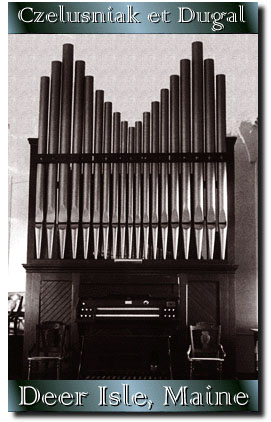


STOPLIST OF THE RESTORED ORGAN
BY MESSRS. CZELUSNIAK ET DUGAL, INC.
GREAT, 58 NOTES | |||
1. | Open Diapason | 8' | Bass en-façade |
2. | Melodia | 8' | |
3. | Dulciana | 8' | TC-46p; Bass Common with Melodia |
4. | Principal | 4' | |
5. | Fifteenth | 2' | |
SWELL, 58 NOTES, ENCLOSED AND EXPRESSIVE | |||
6. | Rohrflute | 8' | |
7. | Salicional | 8' | TC-46p; Bass Common with Rohrflute |
8. | Flute Harmonic | 4' | |
PEDAL, 27 NOTES | |||
9. | Bourdon | 16' | |
ACCESSORIES | |||
10. | Swell to Great coupler | ||
11. | Great to Pedal coupler | ||
12. | Swell to Pedal coupler | ||
13. | Swell Tremolo | ||
SUMMARY | |||
13 registers, 9 ranks, 467 pipes; 2 1/2" l water column wind pressure | |||
| The Swell and Great divisions are located on one, large, double bar-and-slider windchest, separated only by Swell shades (no tuning passage); the Swell pallet bung and tuning access are at the rear of the chest and casework enclosure (service space at the rear of the instrument); 1/2 HP Zephyr Organ Blower attached.
Text by the organist, Vernon D. Gotwals, Jr.
|
